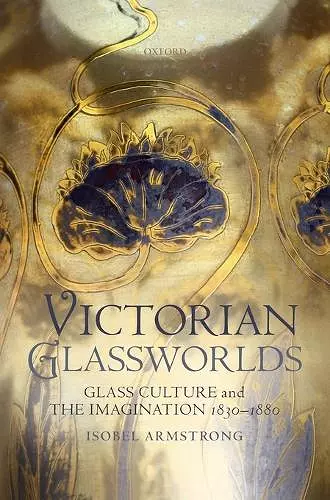Victorian Glassworlds
Glass Culture and the Imagination 1830-1880
Format:Hardback
Publisher:Oxford University Press
Published:24th Apr '08
Currently unavailable, and unfortunately no date known when it will be back

Isobel Armstrong's startlingly original and beautifully illustrated book tells the stories that spring from the mass-production of glass in nineteenth-century England. Moving across technology, industry, local history, architecture, literature, print culture, the visual arts, optics, and philosophy, it will transform our understanding of the Victorian period. The mass production of glass in the nineteenth century transformed an ancient material into a modern one, at the same time transforming the environment and the nineteenth-century imagination. It created a new glass culture hitherto inconceivable. Glass culture constituted Victorian modernity. It was made from infinite variations of the prefabricated glass panel, and the lens. The mirror and the window became its formative elements, both the texts and constituents of glass culture. The glassworlds of the century are heterogeneous. They manifest themselves in the technologies of the factory furnace, in the myths of Cinderella and her glass slipper circulated in print media, in the ideologies of the conservatory as building type, in the fantasia of the shopfront, in the production of chandeliers, in the Crystal Palace, and the lens-made images of the magic lantern and microscope. But they were nevertheless governed by two inescapable conditions. First, to look through glass was to look through the residues of the breath of an unknown artisan, because glass was mass produced by incorporating glassblowing into the division of labour. Second, literally a new medium, glass brought the ambiguity of transparency and the problems of mediation into the everyday. It intervened between seer and seen, incorporating a modern philosophical problem into bodily experience. Thus for poets and novelists glass took on material and ontological, political, and aesthetic meanings. Reading glass forwards into Bauhaus modernism, Walter Benjamin overlooked an early phase of glass culture where the languages of glass are different. The book charts this phase in three parts. Factory archives, trade union records, and periodicals document the individual manufacturers and artisans who founded glass culture, the industrial tourists who described it, and the systematic politics of window-breaking. Part Two, culminating in glass under glass at the Crystal Palace, reads the glassing of the environment, including the mirror, the window, and controversy round the conservatory, and their inscription in poems and novels. Part Three explores the lens, from optical toys to 'philosophical' instruments as the telescope and microscope were known. A meditation on its history and phenomenology, Victorian Glassworlds is a poetics of glass for nineteenth-century modernity.
Intellectually, theoretically, and methodologically, Victorian Glassworlds is a remarkable study to which scholars working in the field of Victorian studies will return again and again. * Mike Sanders, Modern Philology *
Armstrong's book is a jewel among academic publications... It is a multifaceted book, the complexity of which - both theoretical and rhetorical - is impressive. * Monika Pietrzak-Franger, The British Society for Literature and Science *
a challenging, major work * Thomas Marks, The Cambridge Quarterly *
Richly researched... A book of great originality and even greater ambition.... in chapter after chapter, Armstrong succeeds in bringing both wide-angle and close-up views of the nineteenth century into fresh focus... a major work * Robert Douglas-Fairhurst, Times Literary Supplement *
Sumptous production quality and copious illustrations... This challenging book is worth the effort for the new window it opens on the crucially important Victorian period. * Nature *
Like the world of glass it describes, this is a book of gleaming virtuosity. We quickly enter a vision of Victorian England that is dazzlingly new - a glass democracy of crystal boulevards and aerial spaces. Light comes flashing to us from every direction, even as the image of human labour and breath remains steadily in view. * Elaine Scarry, Cabot Professor of Aesthetics and the General Theory of Value, Harvard University *
a brilliant and challenging exploration... remarkable * Kate Flint, The Review of English Studies *
this marvellous book tells the story of the creation, in the nineteenth century, of whole worlds of glass, with languages and cultures to go with each of them. There is news on every page, and lovingly evoked detail in profusion, but there is also deeply reflective thought and theory. Anyone else might have got lost among these treasures, but Isobel Armstrong always knows just where she is, even when, especially when, she manages to be in so many places at once. Her learning is prodigious but so is her unfailing and enticing clarity. * Michael Wood *
the book embodies its subject matter by casting prismatic rays of thought in a myriad of unexpected directions * Andrew Rudd, True Principles *
a thoughtful, painstaking and impressively scholarly book which covers an enormous amount of ground in some detail. It will be invaluable resource for serious students of Victorian society, arts and culture * Vulpes Libris *
a rich, vituoso concoction of literary and historical sources ... It is full of clever and challenging ideas about a material that, since the Victorian period, has become an essential component of modern life. * Peter Cormack, Journal of Stained Glass *
- Winner of Winner of the MLA's James Russell Lowell Prize 2009 Shortlisted for The British Society for Literature and Science Book Prize 2009.
ISBN: 9780199205202
Dimensions: 255mm x 180mm x 30mm
Weight: 1090g
472 pages